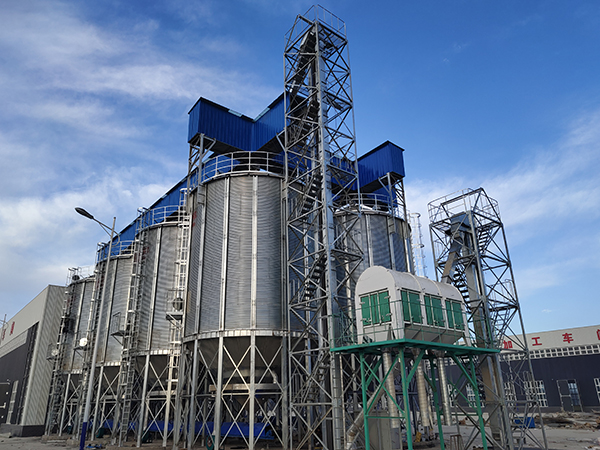Steel Silo|Main Structures and Functions of Steel Silo
Steel silo are widely used in agriculture, industry, and commerce for storage purposes. Their primary structures include the silo body, base, support structure, loading and unloading system, ventilation system, and monitoring system.
- Main Advantages of Wheat Silo in Uganda
- Main Functions of Wheat Silo in Uganda
- Corn mill factory in Mali
- Maintenance Methods for Wheat Silo in Uganda
- Maintenance Methods for a Rice Silo in Uganda
- Wheat mill supplier in Malawi
- Installation Process of a Rice Silo in Uganda
- Structural Composition of a Rice Silo in Uganda
- Flour mill sale in Rwanda
- Main Advantages of Rice Silo in Uganda
- Primary Functions of Rice Silo in Uganda
- Grinding mill cost in Libya
Main Structures and Functions of Steel Silo
Steel silo are widely used in agriculture, industry, and commerce for storage purposes. Their primary structures include the silo body, base, support structure, loading and unloading system, ventilation system, and monitoring system. These structures each have their functions, ensuring the stability, safety, and functionality of the steel silos. Below is a detailed description of the main structures and their functions.


Main Structures of Steel Silo
Silo Body
Function: The silo body is the main part of the steel silo, used for storing materials. It is usually made of high-strength steel plates, providing strong load-bearing capacity and durability.
Features: The silo body is typically designed in a cylindrical shape, which offers excellent structural strength and sealing performance, effectively preventing moisture and contamination of the materials.
Base
Function: The base supports the silo body, bearing the weight of the silo and the materials stored inside, ensuring the stability of the steel silo.
Features: The base is usually made of concrete or steel structure. The design must consider the load-bearing capacity and stability of the foundation to prevent tilting and subsidence.
Support Structure
Function: The support structure includes columns, beams, and other components that support and reinforce the silo body, enhancing its stability and load-bearing capacity.
Features: The support structure should be reasonably designed to effectively distribute and transfer the load of the silo body, preventing deformation and collapse.


Loading and Unloading System
Function: The loading and unloading system is used for the loading and unloading of materials and typically includes feed ports, discharge ports, and conveying equipment.
Features: The design of the loading and unloading system should consider the convenience and safety of operations, ensuring that materials can be smoothly loaded and unloaded, reducing losses and contamination.
Ventilation System
Function: The ventilation system regulates the temperature and humidity inside the silo, preventing the stored materials from becoming moldy and damaged.
Features: The ventilation system usually includes ventilation openings and exhaust fans. The design should consider ventilation efficiency and energy consumption to ensure a suitable internal environment.
Monitoring System
Function: The monitoring system continuously monitors the temperature, humidity, and material conditions inside the silo, ensuring the safety of the storage environment and the quality of the materials.
Features: The monitoring system usually includes sensors, monitoring instruments, and data transmission devices, allowing for remote monitoring and data analysis to improve management efficiency.


Functions of Steel Silo
Storage Function
Description: The primary function of steel silos is to store various materials such as grain, feed, cement, and coal, providing a large capacity and efficient storage space.
Advantages: Through reasonable design and high-quality materials, steel silos ensure the safety and quality of materials during storage.
Protection Function
Description: Steel silo have excellent sealing performance and structural strength, effectively preventing external air, moisture, and contaminants from entering the silo.
Advantages: This safeguard prevents dampness, mold, and contamination, prolonging material storage time and maintaining quality.
Management Function
Description: Ventilation and monitoring systems enable steel silos to efficiently control the internal environment and material condition.
Advantages: Real-time monitoring and adjustments ensure the internal environment’s suitability, enhancing material storage efficiency and safety.
Convenience Function
Description: The loading and unloading system of steel silos is reasonably designed, allowing for easy loading and unloading operations.
Advantages: This improves the convenience and safety of operations, reducing labor intensity and time costs.
Conclusion
Steel silo are efficient and reliable storage equipment, comprising key components such as the silo body, base, and support structure. They also include essential systems like the loading and unloading system, ventilation system, and monitoring system for optimal functionality. Each of these structures plays a crucial role in ensuring the stability, safety, and functionality of the steel silo. With reasonable design and management, steel silos can provide excellent storage services to meet the storage needs of various materials.








